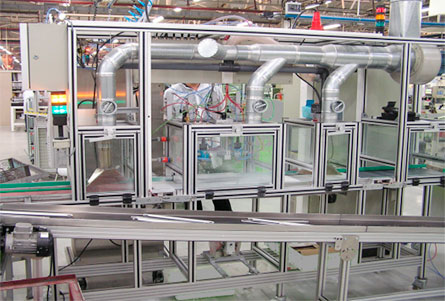Paint Fluxing – Pros and Cons, Part 1
Selective Pre-Fluxing with Adhesives – Fashion or Progress
Summary
Over the last 15 years, selective pre-fluxing – also called paint fluxing or binder-based fluxing – has evolved as an alternative method for applying flux powder in aluminium brazing industry. There are many activities to define process parameters of fluxing with adhesives.
The first part of this paper outlines key features of pre-fluxing. The methodology for measurements of physical characteristics of binders and paint flux mixtures are described. General rules for behaviour of flux paints in brazing process are discussed together with some examples of flux paint features.
In the second part a case study is shown to illustrate common challenges when brazing with flux paint. The last part of this paper provides a cost comparison as guidance for choosing the right fluxing method for two different cases, one being extremely negative and the second as a positive case.
1. Introduction
In aluminium brazing industry fluxing is one of the most important steps in the production process. Flux water slurry application is considered as a standard and as a matter of fact very robust methodi. We believe that about 70% of overall fluxing activities are done by flux water slurry spray. This method has however certain disadvantages like troublesome slurry preparation and requirements for large and sometimes expensive machinery.
In order to lower production costs, new fluxing technologies have been introduced. One of them is called paint fluxing or binder-based fluxing which allows for elimination of wet fluxing process from the brazing line. Actually, the prefluxing process can be even done by an external company/subcontractor. It is nevertheless still a process of coating, which is done to particular component surfaces of the whole assembly – usually before the components are assembled.
In the industrial practise – particularly when one is in contact with many different users of the prefluxing technology – it is quite important to define the basic features and properties of discussed technology.
Flux Paint:
A mixture of brazing flux with binder, demineralised water or organic solvent, and thickener (the latter not always obligatory)
Binder:
Organic complex compounds, which are activated by curing – to provide adhesion of flux particles to the painted surface.
Thickener:
Organic substance, which is used to adjust viscosity and to facilitate re/mixing of the flux paint.
Curing:
Drying of the painted parts – usually with a blow of hot air (about 150°C). During that process liquid carrier (water or organic solvent) is evaporated and binder becomes activated to provide adhesion.
Adhesion:
Qualitative or quantitative measure by which strength of the flux particles bonding to the painted surface is determined. There are many different methods to describe adhesion of the flux paint. At Solvay we are using a simple quantitative method: A coated and cured coupon is placed in a holder positioned on a scale, a steel wedge is moved along the coupon with a gradual pressure increase. The weight at which the first scratches appear is a numerical value for adhesion.
Debinding:
Removal process of the binder from the painted surface done by treatment with high temperature, either in air or in ambient atmosphere.
Binder must be removed before reaching brazing temperature; otherwise the carbon residue will interfere with the brazing process – leaving both black stains on the part surfaces and very often leading to lack of brazing. Removal of the binder is done by applying high temperature to the assembled parts. In most cases the process of binder removal is realized in the brazing line both in the dryer and brazer.
2. Basic Rules for Flux Painting
The process of coating can be done by spraying, roller coating, brushing, or dipping. Uniformity of coating is very important, any agglomerates and lumps must be avoided. The flux paint can be prepared without thickener. Practically it is required in the mixture when a longer storage is expected (i.e. more then few days). There is an optimal temperature for curing resulting in maximum adhesion. Curing at ambient temperature is possible, but it will yield lower adhesion. Curing at too high temperature can lead to significant loss of adhesion.
Apart from the curing condition, adhesion also depends on the ratio of binder in the mixture (the more binder in the mixture the stronger adhesion), and the type of the binder (as a rule of thumb: the higher flash point of the binder the stronger adhesion). The most common method for prefluxing with binder mixture is using an atomized spray method on a machine which performs degreasing, painting and curing.
Will be continued soon.


Hinterlasse einen Kommentar
An der Diskussion beteiligen?Hinterlasse uns deinen Kommentar!